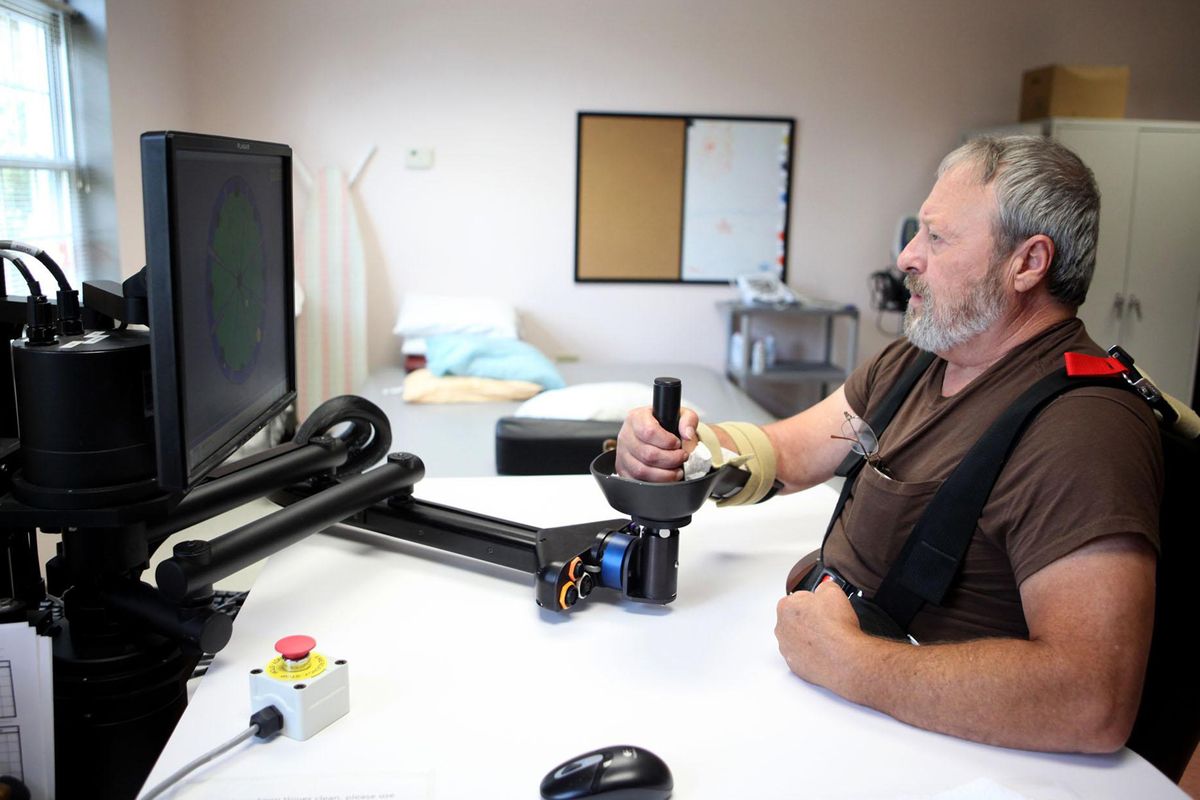Nontraditional therapy for strokes producing remarkable results

When Frank McKinney began therapy at Dr. Lumy Sawaki’s lab, his right arm was bent permanently to his chest and his fingers stayed perpetually clenched.
Although McKinney had worked hard to relearn how to walk and talk after a stroke two years earlier, his arm remained mostly useless.
Yet weeks into his new therapy, he can slowly extend his arm and introduce himself with a handshake.
He can use both arms in the shower.
He can stir his own coffee.
“Every little step is a step forward,” says Sawaki.
“It’s all fun for me,” says McKinney, 63, clearly enjoying the results of his hours-long therapy sessions. “I’m really getting something out of it.”
McKinney’s seemingly remarkable progress is typical of the kind of change that the therapy can make, Sawaki says.
Sawaki, who opened her grant-funded lab at Cardinal Hill Rehabilitation Hospital in Lexington, Ky., last year, says there is a fundamental difference between traditional methods and her approach.
Traditionally, she says, work with stroke patients centers on retraining other unaffected parts of the brain to make up for what was damaged during the internal electrical storm that is a stroke.
Her approach is to revive the injured part of the brain so it can, in laymen’s terms, be jump-started back into action.
The goal, she says, “is to harness the ability of the brain to rewire.”
Sawaki, who is also part of the University of Kentucky’s Department of Physical Medicine and Rehabilitation, aims to help patients with the most severe limitations – those who have lost as much as 80 percent of their mobility.
“Those are the people that need to be in the lab,” she says, adding that those people often don’t have any other options because traditional therapies have been tried and have failed.
“What is truly exciting about Dr. Sawaki’s research is that she is charting a new path of discovery that challenges our current thinking,” says Joe E. Spring, the Cardinal Hill Endowed Chair in Neurorehabilitation, who helped bring Sawaki to the university.
“I truly believe that her ongoing and future research accomplishments will redefine the standard of rehabilitation care in patients who experience limited motor function due to stroke, spinal cord injury and traumatic brain injury.
“It is clear that the outcome of her research has the potential to restore a level of quality of life in these patients far beyond what could be accomplished in the past.”
Once it’s clear a patient might benefit from the therapy, the first step is to show the extent of the damage to the brain.
Using functional magnetic resonance imaging to map the activity in the brain, Sawaki creates an X-ray-like image that maps the shape of the brain and also tracks electrical activity that shows which part of the brain is working.
Knowing what parts of the brain aren’t working allows Sawaki’s team to pinpoint sections that need to be stimulated.
That stimulation, called transcranial magnetic stimulation, uses magnetic fields to stimulate brain cells. Using what looks like a tricked-out paddle, Sawaki can, with a switch, stimulate the specific nerves responsible for particular movements.
Demonstrating it on herself, she holds the paddle over her head and makes her right arm jump as if a puppet master has just yanked on a string.
On a patient, this burst is repeated dozens of times. Often, she says, the patient falls asleep.
“Everybody goes to sleep,” Sawaki says, “it’s so monotonous.”
But the newly awakened brain is then given exercises to build on what the stimulation begins.
A kind of specialized computer game is used. McKinney and other patients try to improve their scores by manipulating a mouse with the help of a robot.
These intense workout sessions, coupled with medicine, have shown promising results, Sawaki says.
“Every patient has shown some improvement,” she says.
This improvement is tracked by remapping the image of the brain to show how previously inactive areas have become active.
Michael Begley doesn’t need a brain scan to know things are getting better.
“It’s improving a little bit each day,” says Begley, who travels from his home in Booneville, Ky., for treatment.
The 58-year-old, who had a stroke in 2007, says he hopes to get back to doing the things he loves: playing bluegrass music, hunting and fishing.
“I’m not giving up,” he says, taking a brief break from treatment in Sawaki’s lab. “My goal is getting back where I once was.”
McKinney was at the hospital for other therapies when he saw a notice about Sawaki’s lab.
When he called, he was told they’d be happy to set up a home visit to see if he would be a good fit for the program.
“I’m right here,” he replied. “I’m in the hospital. I’ll come right down.”
That kind of enthusiasm is key to overall recovery, said Sawaki.
Although the high-tech therapies can jump-start recovery, the patients still have to do a lot of hard work.
McKinney is in.
“I’m kind of tired of sitting around feeling sorry for myself,” he says. “Whatever I can do to get better.”